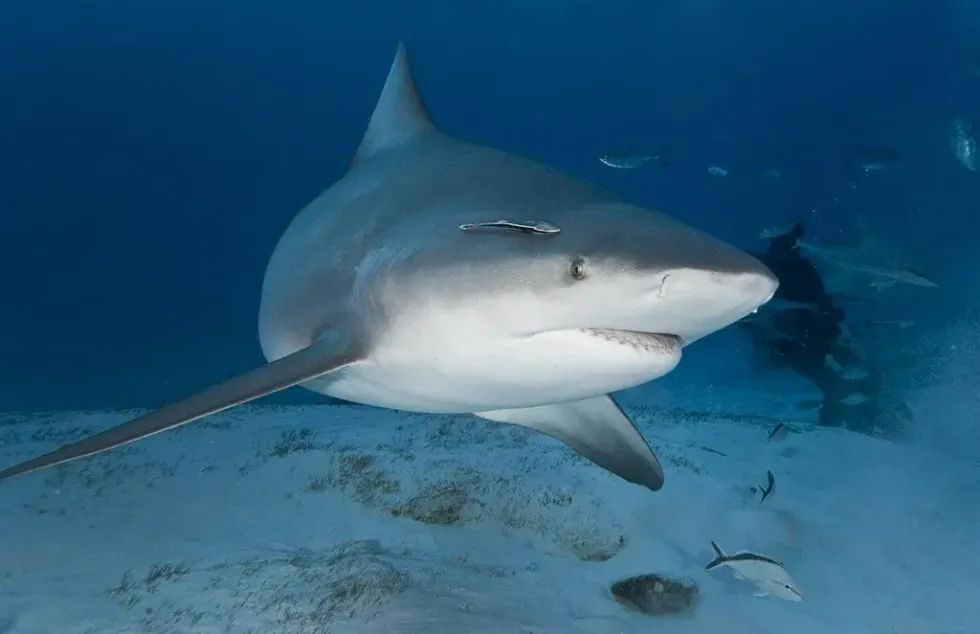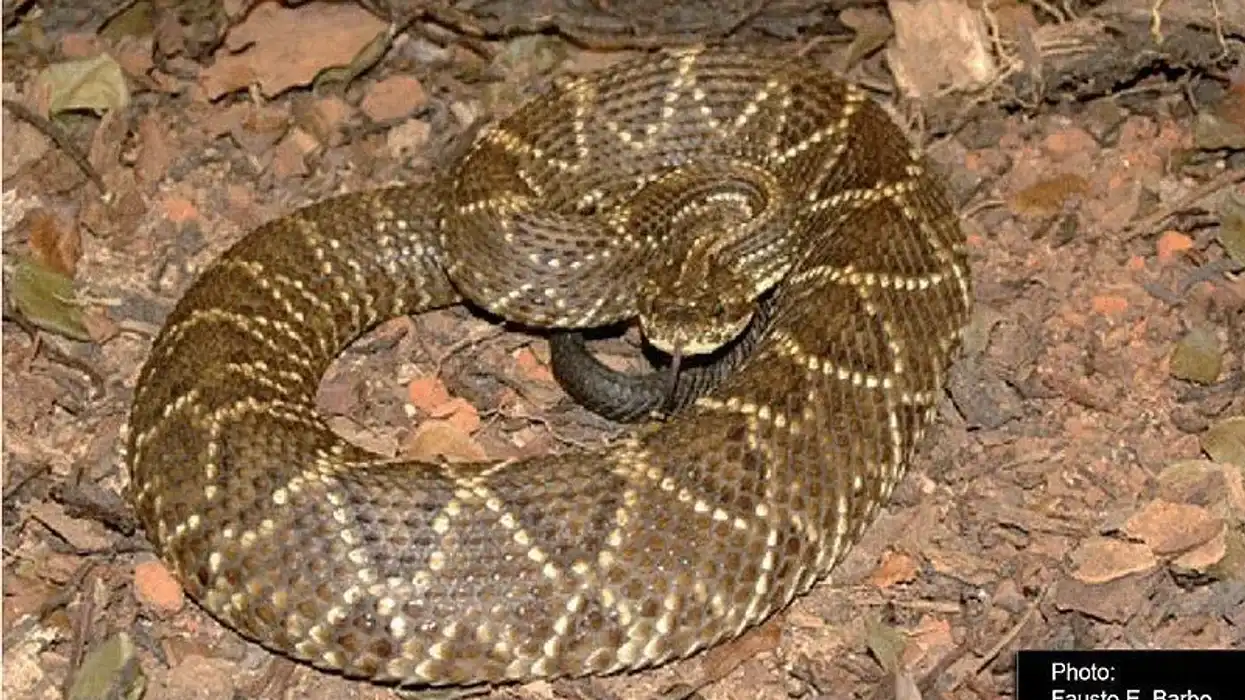If you want to read about sharks, you will love to read about the Bull shark (Carcharhinus leucas). Bull sharks (Carcharhinus leucas) are a near-threatened species of sharks that can survive in both saltwater and freshwater, making them native to the ocean, river, and lakes.
The name Bull shark comes from their snout and the habit of headbutting their prey before killing them. Bull shark attack is a common occurrence in coastal areas.
After all, bull sharks live in coastal waters and often come in contact with humans by swimming upriver.
Bull sharks are fast swimmers and the fastest speed they can swim is 25 mph. The population distribution of bull sharks is all over the world as they live from coast to coast and water body shores.
Bull sharks feed on the smaller shark species, stingrays, other Bull sharks, dolphins, sea turtles, birds, and other crustaceans. Bull sharks have the meanest bite in the entire species of sharks as Bull shark teeth have a bite force of 6000 newtons at the back of the mouth and over 2000 newtons at the front.
With that said, here are some of the best facts about the Bull shark (Carcharhinus leucas) for kids that will help them learn more about these interesting species of sharks!
If you enjoy our fun facts about Bull sharks, you might also want to read our articles on Caribbean reef shark and skate fish.
Bull Shark Interesting Facts
What type of animal is a Bull Shark?
A Bull shark is a species of shark that is infamous for being behind most shark attacks due to its aggressive behavior.
What class of animal does a Bull Shark belong to?
Bull sharks belong to the class of Chondrichthyes. Animals in this family are known to have skeletons made of cartilages instead of bones. All sharks belong to the cartilaginous fish family.
How many are there in the world?
An approximate number isn't available on the populations of Bull sharks as they are found all over the world and are hard to keep a track of.
Where does a Bull Shark live?
Bull sharks live in shallow coastal waters and in depths ranging from 1-150 m, and they are often found in estuaries, harbors, lagoons, and river mouths all over the globe.
What is a Bull Shark's habitat?
Bull sharks are known to have a vast habitat because of their ability to survive in freshwater as well as saltwater. They are found alongside coastal areas. Bull sharks have found their way into the local vocabulary of humans because they can be found almost all over the world.
Who do Bull Sharks live with?
Bull sharks are known to wander alone, but they might come as a group when they hunt for prey.
How long does a Bull Shark live?
The average lifespan of a mature Bull shark in nature is 12-16 years, but a Bull shark has been recorded to survive 30 years in captivity.
How do they reproduce?
Male Bull sharks reach sexual maturity at the age of 15 years, while females reach sexual maturity at 18 years of age. Being mammals, female bull sharks give birth to live pups in freshwater in order to protect them from the dangerous environment of the seas and oceans after an 11 month gestation period.
These juvenile Bull sharks enter estuaries with low salinity marine waters and use them as nursery grounds to develop.
What is their conservation status?
The IUCN Red List has marked bull sharks as a Near Threatened shark species. Humans are one of their natural predators, hunting them in coastal, shallow, and tropical waters for shark fin and oil.
Bull Shark Fun Facts
What do Bull Shark look like?
Bull sharks have a thick, stout body with a long pectoral fin with a blunt snout. Bull sharks have a gray coat on top and are white below. Younger bull sharks can be differentiated by their dark-tipped fins.
How cute are they?
As aggressive as they are, their looks don't do justice to them as they are medium-sized sharks. They can't be called cute outright but do have some cuteness factor to them with their chubby and stout body.
How do they communicate?
Bull sharks and all other species of sharks communicate with one another by arching their bodies visually. Sharks use a special organ named 'lateral line' which helps them feel vibrations in the water, helping them navigate marine waters. They are also known to use this sense to locate prey by detecting blood and finding mates.
How big is a Bull Shark?
Bull shark size varies from male to female sexes. Female bull sharks are larger than males in comparison.
At birth, a bull shark pup weighs around 6.6 lb (3 kg) and is 23.6-27.9 in (60-71 cm) long. An immature female has an average length of 74.4 in (189 cm) and an immature male is around 76 in (193 cm). Both have similar weights at around 116.8-119.1 lb (53-54 kg).
At adulthood (age 18), females can weigh up to 244.7 lb (111 kg) and can grow up to 131.9 in (335 cm). Whereas males on reaching adulthood at the age of 14, weigh around 209 lb (95 kg) and are 89.8 in (228 cm) long.
The sizes of adults vary in geographical regions. North American Bull sharks are larger than those found in Costa Rica and other regions. The largest female Bull shark ever found in Costa Rica was measured at around 98.8 in (251 cm) and the largest male was around 94.9 in (241 cm) long.
How fast can a Bull Shark swim?
Like all other sharks, Bull sharks are agile in the water which makes them dangerous as a predator. These sea creatures can swim at a maximum speed of 25 mph (40.2 km/h)!
How much does a Bull Shark weigh?
At birth, a pup Bull shark may weigh around 6.6 lb (3 kg). Immature female and male Bull sharks weigh the same at around 116.8-119.1 lb (53-54 kg).
Adult Bull sharks weigh differently. Females weigh around 244.7 lb (111 kg) and males are about 209 lb (95 kg) in comparison. A Bull shark weighing around 765 lb (347 kg) according to the IGFA (International Game Fish Association) was caught in Australia, which has been recorded as the heaviest Bull shark ever found.
What are their male and female names of the species?
Unlike other animals, sharks do not have specific names assigned to their male and female counterparts.
What would you call a baby Bull Shark?
A baby Bull shark is called a pup. They are laid by the females in flat areas along the shore of coastal areas to protect them from predators and to help them thrive in nature.
What do they eat?
Bull sharks eat small sharks, bony fish, other bull sharks, and stingrays. In other instances, their diets include sea turtles, crustaceans, birds, and dolphins. The feeding ground for Bull sharks is located mostly in murky water systems where they attack prey that include sea turtles and other fishes. The murky water helps them to camouflage with their surroundings.
Are they dangerous?
Bull sharks are obviously at the top of the food chain because of their aggressive nature, making them apex predators. Bull shark bites have been recorded as the strongest bite of any other shark bites that have been studied.
They are notorious as most shark attacks on humans are by Bull sharks because of their close proximity to the human population, especially in coastal areas. We are much more likely to get attacked by Bull sharks than Great White sharks or Tiger sharks.
Would they make a good pet?
Bull sharks are apex predators and are hostile and unfriendly to everything around them, which makes them savage, and outright deadly. They are unsuitable to be kept as pets since more human deaths come at the jaws of Bull sharks than any other shark species.
But unlike Great White sharks, they can live in captivity. It has been recorded that the oldest Bull shark in captivity, has lived up to 30 years. The Oklahoma Aquarium in North America houses 10 Bull sharks in a 500000-gallon tank.
Did you know...
Bull sharks are more likely to come into contact with the human population as they are the only sharks to be able to live in freshwaters. They are known to migrate from saltwater to freshwaters.
They can be found upriver in the Amazon river basins, Mississippi River, and Lake Nicaragua.
Because of their ability to thrive in freshwater and saltwater, they have a wide range of habitats.
With that, they have been a part of the local legends, and they have been given names like the Zambezi shark in Africa, Lake Nicaragua shark in Nicaragua, freshwater whaler, estuary whaler, swan river whaler, shovelnose shark, cub shark, van Rooyen's shark, Fitzroy Creek Whaler and Ganges river shark (Glyphis gangeticus).
Fun fact, there's a shark-infested golf course in Brisbane, Australia! The Carbrook Golf Club near Brisbane is situated next to the Logan River, and because of floods, some Bull shark pups were stranded in the lake, and have been living there ever since.
Bull shark fin is eaten as a delicacy in countries like Japan and Australia.
How long is a Bull Shark?
Female Bull sharks can grow up to 131.9 in (335 cm) and males can grow up to 84 in (213.4 cm).
Differences and similarities with other common fish
Bull sharks are easily able to adapt to freshwater bodies, which allows them to have an unusual migratory pattern where they give birth in freshwater bodies, unlike other species of sharks. While stout, like most other fishes, the Bull shark has a streamlined body starting from its head, something we do not see with the Hammerhead shark.
Here at Kidadl, we have carefully created lots of interesting family-friendly animal facts for everyone to discover! Learn more about some other fish including codfish, or fluke fish.
You can even occupy yourself at home by drawing one on our Bull shark coloring pages.









